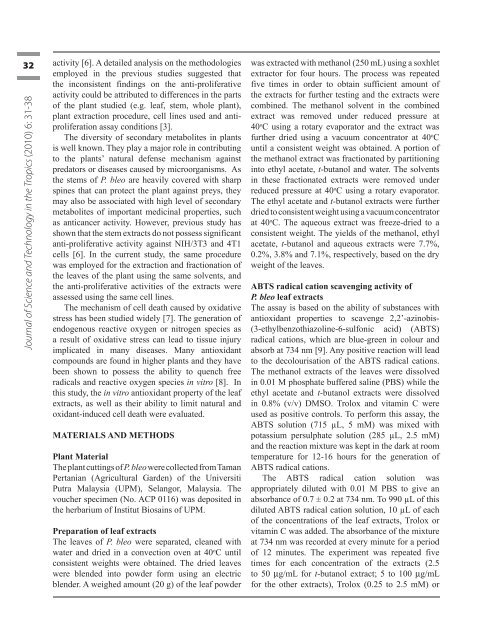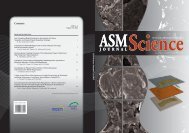Download - Akademi Sains Malaysia
Download - Akademi Sains Malaysia
Download - Akademi Sains Malaysia
You also want an ePaper? Increase the reach of your titles
YUMPU automatically turns print PDFs into web optimized ePapers that Google loves.
32<br />
Journal of Science and Technology in the Tropics (2010) 6: 31-38<br />
activity [6]. A detailed analysis on the methodologies<br />
employed in the previous studies suggested that<br />
the inconsistent findings on the anti-proliferative<br />
activity could be attributed to differences in the parts<br />
of the plant studied (e.g. leaf, stem, whole plant),<br />
plant extraction procedure, cell lines used and antiproliferation<br />
assay conditions [3].<br />
The diversity of secondary metabolites in plants<br />
is well known. They play a major role in contributing<br />
to the plants’ natural defense mechanism against<br />
predators or diseases caused by microorganisms. As<br />
the stems of P. bleo are heavily covered with sharp<br />
spines that can protect the plant against preys, they<br />
may also be associated with high level of secondary<br />
metabolites of important medicinal properties, such<br />
as anticancer activity. However, previous study has<br />
shown that the stem extracts do not possess significant<br />
anti-proliferative activity against NIH/3T3 and 4T1<br />
cells [6]. In the current study, the same procedure<br />
was employed for the extraction and fractionation of<br />
the leaves of the plant using the same solvents, and<br />
the anti-proliferative activities of the extracts were<br />
assessed using the same cell lines.<br />
The mechanism of cell death caused by oxidative<br />
stress has been studied widely [7]. The generation of<br />
endogenous reactive oxygen or nitrogen species as<br />
a result of oxidative stress can lead to tissue injury<br />
implicated in many diseases. Many antioxidant<br />
compounds are found in higher plants and they have<br />
been shown to possess the ability to quench free<br />
radicals and reactive oxygen species in vitro [8]. In<br />
this study, the in vitro antioxidant property of the leaf<br />
extracts, as well as their ability to limit natural and<br />
oxidant-induced cell death were evaluated.<br />
MATERIALS AND METHODS<br />
Plant Material<br />
The plant cuttings of P. bleo were collected from Taman<br />
Pertanian (Agricultural Garden) of the Universiti<br />
Putra <strong>Malaysia</strong> (UPM), Selangor, <strong>Malaysia</strong>. The<br />
voucher specimen (No. ACP 0116) was deposited in<br />
the herbarium of Institut Biosains of UPM.<br />
Preparation of leaf extracts<br />
The leaves of P. bleo were separated, cleaned with<br />
water and dried in a convection oven at 40 o C until<br />
consistent weights were obtained. The dried leaves<br />
were blended into powder form using an electric<br />
blender. A weighed amount (20 g) of the leaf powder<br />
was extracted with methanol (250 mL) using a soxhlet<br />
extractor for four hours. The process was repeated<br />
five times in order to obtain sufficient amount of<br />
the extracts for further testing and the extracts were<br />
combined. The methanol solvent in the combined<br />
extract was removed under reduced pressure at<br />
40 o C using a rotary evaporator and the extract was<br />
further dried using a vacuum concentrator at 40 o C<br />
until a consistent weight was obtained. A portion of<br />
the methanol extract was fractionated by partitioning<br />
into ethyl acetate, t-butanol and water. The solvents<br />
in these fractionated extracts were removed under<br />
reduced pressure at 40 o C using a rotary evaporator.<br />
The ethyl acetate and t-butanol extracts were further<br />
dried to consistent weight using a vacuum concentrator<br />
at 40 o C. The aqueous extract was freeze-dried to a<br />
consistent weight. The yields of the methanol, ethyl<br />
acetate, t-butanol and aqueous extracts were 7.7%,<br />
0.2%, 3.8% and 7.1%, respectively, based on the dry<br />
weight of the leaves.<br />
ABTS radical cation scavenging activity of<br />
P. bleo leaf extracts<br />
The assay is based on the ability of substances with<br />
antioxidant properties to scavenge 2,2’-azinobis-<br />
(3-ethylbenzothiazoline-6-sulfonic acid) (ABTS)<br />
radical cations, which are blue-green in colour and<br />
absorb at 734 nm [9]. Any positive reaction will lead<br />
to the decolourisation of the ABTS radical cations.<br />
The methanol extracts of the leaves were dissolved<br />
in 0.01 M phosphate buffered saline (PBS) while the<br />
ethyl acetate and t-butanol extracts were dissolved<br />
in 0.8% (v/v) DMSO. Trolox and vitamin C were<br />
used as positive controls. To perform this assay, the<br />
ABTS solution (715 µL, 5 mM) was mixed with<br />
potassium persulphate solution (285 µL, 2.5 mM)<br />
and the reaction mixture was kept in the dark at room<br />
temperature for 12-16 hours for the generation of<br />
ABTS radical cations.<br />
The ABTS radical cation solution was<br />
appropriately diluted with 0.01 M PBS to give an<br />
absorbance of 0.7 ± 0.2 at 734 nm. To 990 µL of this<br />
diluted ABTS radical cation solution, 10 µL of each<br />
of the concentrations of the leaf extracts, Trolox or<br />
vitamin C was added. The absorbance of the mixture<br />
at 734 nm was recorded at every minute for a period<br />
of 12 minutes. The experiment was repeated five<br />
times for each concentration of the extracts (2.5<br />
to 50 µg/mL for t-butanol extract; 5 to 100 µg/mL<br />
for the other extracts), Trolox (0.25 to 2.5 mM) or<br />
Jostt vol 6.indd 32 7/22/10 10:09:08 PM

















